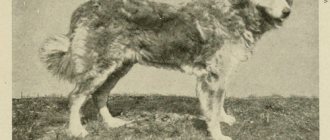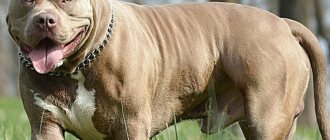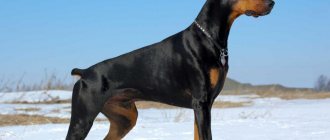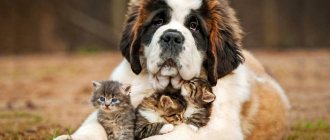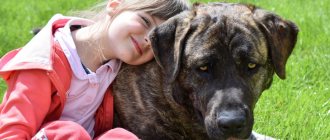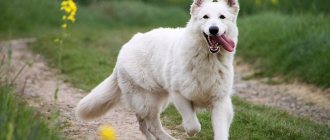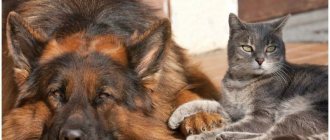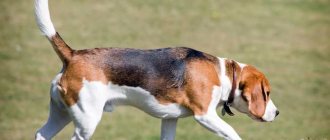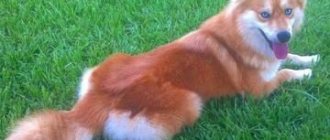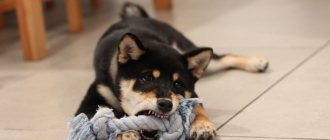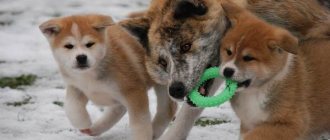Home » Dog Breeds
Classification Origin: Hungary
Class: according to the IFF, group – 1, section – 1, number – 53.
Color: only white, black dogs are also bred, but this color does not meet the breed standard
Dimensions: height for males is at least 70 cm, for females - at least 65 cm, males weigh from 50 to 60 kg, females - from 40 to 50 kg
Lifespan: 10-12 years
The Komondor is a dog adapted to work as a shepherd and guard. Luxurious wool allows it to camouflage perfectly in a sheep flock.
Looking at the photo, we can assume that this animal is quite large and has a lot of weight. But in fact, it is about half the weight of many other breeds of its size, such as the Hovawart, German Boxer and Tosa Inu .
Under the long rope dreadlocks you will not see any eyes, no paws, no tail - only the black button of the nose stands out against the background of the white fur.
This dog, in the absence of a potential threat, is calm and balanced, but when danger approaches, it becomes aggressive and will not hesitate to attack the enemy.
The Komondor does not attack like a fighting dog , he delivers powerful blows with his head, which completely demoralizes the enemy - this is how he breaks the back of a wolf who attacked the flock of sheep entrusted to him.
The fury and swiftness with which the Komondor attacks can only be slightly mitigated by the complete absence of resistance.
- 2 Psychology
- 3 Application
- 4 How to choose a dog
- 5 Features of care
- 6 Combing
- 7 Walking
- 8 Food
- 9 Health
- 10 Characteristic diseases
- 11 Vaccinations
- 12 Mating
History of the breed
As a result of research, scientists have come to the conclusion that the ancestors of the Komondor are ancient shepherd dogs crossed with wolves (by the way, the modern hybrid of a wolf and a shepherd dog is called a wolfdog ). Also, some notice a certain similarity between the Komondor and the South Russian Shepherd Dog .
But the Hungarians have another version, or rather a legend, that this dog came from the unnatural “marriage” of a sheep and a wolf.
The Komondors came to the territory of Hungary from the coastal regions of the Black Sea, where they lived together with the Magyar tribes. There they were used as guards and helped herd flocks.
But the Golden Horde forced the tribes out of their inhabited territory, and loyal dogs followed them. About ten centuries have passed since then, but these shepherd dogs still live in Hungary.
Due to the fact that the Komondor was prohibited from crossing with other dog breeds, he completely retained his original appearance and character traits.
Interesting! A king among shepherds - this is how the medieval author Amos Comenius dubbed this dog. This “talking” nickname was liked by many connoisseurs of this amazing breed and they remember it even today. Often they simply say “king”, forgetting that “among the shepherds”!
The origin of the breed's name is also controversial. Some, starting from the nickname given by the ancient author, argue that the name Komondor is not accidental, since translated from Italian “cane commodore” it means “king of dogs”.
Others believe that the Magyars themselves named these animals and the name in no way depends on the medieval nickname.
Character
The Komondor has proven itself to be an excellent guard dog; it is brave, fearless and always vigilant. Without hesitation, he will defend family members and property, despite the fact that in everyday life he is a sweet, friendly and sociable dog who does not show aggression towards peaceful dogs and people. True, all this is subject to good socialization. The Komondor will be good with children, but you should not leave such a large dog and a very small child alone, as he may inadvertently push or scratch the baby. The Komondor is not prone to flattery and affection; he has a firm, confident character.
The Komondor is a dog of one owner, but he will also selflessly protect other family members and the owner's household (other dogs, cats, chickens, livestock and others).
The Komondor is very wary of strangers. If they are friends of the owner, he accepts them, but without much joy. He needs time to get used to the person. During the day, the commander prefers to lie where the entire territory is clearly visible, and at night he regularly makes rounds. The Komondor is incredibly agile. It seems that he is dozing in the shade of the trees, but in a split second the dog jumps up and finds himself near the object of his attention.
Komondors are very independent and headstrong.
This is primarily due to the fact that dogs have worked without human command for centuries. They are used to making decisions on their own, the skills of guard duty and protecting the territory are in their blood and do not need special training. The Komondor notifies of the approach of strangers by barking; with this he also wants to scare away the uninvited guest, avoiding direct conflict. This quality has been preserved in modern dogs. With a loud, menacing voice, they bark a lot and with pleasure.
Although the Komondor is called a shepherd dog, it does not drive livestock; it is responsible for guarding the herd, which is why it is sometimes called the Hungarian wolfhound.
Psychology
The behavior and character of an adult Komondor dog largely depends on timely and correct socialization. The puppy should be taught from an early age to communicate with other dogs and people, and also be adapted to different situations.
If these requirements are neglected, then aggression will prevail in the pet’s character.
An animal that develops in a kind, caring atmosphere will become an excellent pet - loving and devoted
- The Komondor matures late - at about three years of age. Looking at the photo, it is impossible to even imagine that such a large dog is capable of acting like a puppy. Every potential owner should know this feature so that the character of a seemingly adult pet does not raise any questions.
- If there is no threat, then representatives of this breed behave calmly. They are completely indifferent to strangers and other people's children. But at the same time they show friendliness towards their owner’s friends.
- The Komondor is always fiercely loyal to its owner and all members of his family. It is very difficult for him to tolerate a change of owner; for this dog such a situation is fraught with stress. And if you choose him as your pet, then remember - this is forever!
- The Hungarian Shepherd is independent and intelligent, but at the same time cunning and stubborn. As a small puppy, she may exhibit leadership tendencies and will try to dominate her owner. Early training - at the age of 4-6 months - will help smooth out the “sharp corners” of character.
Interesting! Komondor males are stubborn, so you should be very careful when choosing a trainer. Bitches, on the contrary, are more affectionate and much easier to train!
- The Komondor learns information quickly, but training must be varied, otherwise the dog will get bored and refuse to follow commands in the future. Training, which always contains a lot of new information, will bring positive results.
Only a positive teaching style is allowed, which will be reinforced with constant praise and treats. Aggressive behavior in the process of education will lead to the formation of negative character traits of the pet
- This dog will become a real “stone wall” for your children. There are no circumstances under which she could harm the babies. The Komondor will happily share games with children, wake them up in the morning and lick them devotedly.
- The guard shepherd dog selflessly guards the house every night, but during the day it takes a long nap. You can only hear a Komondor's bark in exceptional cases; he even attacks silently. This dog's voice is deep and very loud.
Training and socialization
Due to its willful and independent nature, it is necessary to take the education and training of the Komondor seriously. A dog needs a firm hand, a calm and confident owner, who will be perceived as a leader. It is necessary to constantly maintain the status of the main one in order to achieve the obedience of the shepherd.
If raised incorrectly, the Komondor grows up obstinate. Poor behavior can also be caused by insufficient physical activity. It is better to keep the dog in a rural area where it will be constantly moving. In an apartment, it will be much more difficult to ensure optimal physical activity.
Throughout his life, the owner must constantly prove his superiority. You should not be allowed to break even minor rules, otherwise the dog will perceive such behavior as the norm.
Training must begin at an early age of the puppy and continue throughout the life of the shepherd dog. Don't overwork your dog with too much training, be patient and reward him with treats. Having learned a lesson, a Komondor will never forget it.
Although training a Hungarian Shepherd is not the most difficult task, it is preferable to contact a specialist. Then the classes will bring not only benefits, but also real pleasure to both the dog and the owner.
The Hungarian Shepherd is very smart, so it immediately understands commands. But because of her independence, she considers whether a particular command is appropriate. Therefore, it is necessary to give the dog time to think, but demand obedience.
Application
Initially, the Komondor dog, like the Kangal , was bred to guard sheep flocks and protect them from predators. The Hungarian Shepherd made the right decisions and acted independently without any prompting from its owner.
She is an excellent watchman, and when an enemy approaches, she quickly attacks and behaves mercilessly.
In the USA, the Komondor occupies a leading position in the list of dogs in demand by the police and security services. They act as service dogs, like the Groenendael , and also as bodyguards for high-ranking officials, including the president of the country. Their main duty is to search for explosives.
In the United States, there is a specialized kennel in which these guard dogs are bred for a slightly different purpose - the Komondor is trained to help sick people and mentally disabled children
Hungarian Shepherd Commander: types
Commander dog
Komondor (commander) is a Hungarian shepherd dog, the pride of dog handlers in Hungary. A large dog weighing up to 60 kg, it is a herding and guard breed. As mentioned above, its peculiarity is the corded structure of its coat, which is why it is also called a “corded” dog.
Interesting to know: The breed was almost lost completely, but after the Second World War it was possible to restore it.
This breed is divided into types:
- White Komondor is the standard breed . Any color other than white, including spotted, is considered a fault.
- Black Komondor is not considered a pure breed, it is a mixed breed.
- Puli is another variety of the breed, a small dog weighing up to 16 kg. Bred for herding and driving livestock, it can be a good companion. Bullets can be black, gray or white.
- A related breed to the Komondor is the Polish Lowland Shepherd. It was also on the verge of extinction, but was restored. The dog is suspicious of strangers, but brave and determined. Able to make independent decisions.
If we think strictly, then there is only one type of Commander breed - white. The remaining species are either mestizos or related breeds that have a common ancestor with the commander, from whom they inherited such a memorable and unusual appearance.
How to choose a dog
A Komondor dog is an expensive pleasure and a rarity, so such a pet is purchased mainly from nurseries. The average price is about $1200.
Dog handlers examine puppies when they are 45 days old. At this time, the main breed standards are identified and their compliance is established. After which the young Hungarian Shepherd is put up for sale.
It is advisable to purchase a puppy as early as possible in order to be able to influence the formation of its character.
When choosing a Komondor puppy, you should pay attention to the absence of the following exterior defects:
- the nose is unevenly colored;
- there is no rim around the eyes;
- the coat is sparse and short;
- the bones are narrow and short;
- the belly is too tucked in;
- the bite is incorrectly formed;
- the tail is short, curled, lying on the croup.
A potential owner should not choose a dog based on a photo, as it is important to take into account its character.
Shyness is unacceptable for a small Hungarian Shepherd, as is excessive aggression. She will not approach strangers right away, being wary, as if studying a new person.
It’s good if the puppy shows curiosity, behaves balanced and calm
The price of a puppy will always be determined by its quality. In addition, the cost is affected by the good name of the nursery and maintenance costs.
Any purebred dog requires a huge amount of work from a reputable breeder, and a too low price may indicate that the pets were bred just right.
An infant puppy is a lottery, since compliance with the standard can only be considered when the dog reaches 6 months of age, so the cost may not be high.
The price of a promising Komondor, who has already grown up and fully meets the breed standards, will be in a completely different range.
Choosing a puppy
The Komondor is a rare breed, so in most cases you have to go to the breeder to get a puppy. When puppies reach 45 days of age, they are examined by an experienced dog handler to ensure they meet breed standards. After this, the puppies are put up for sale. Komondor puppies are not a cheap pleasure: their average price is around $1000 – 1500. Often, future owners wait for the puppies to grow up a little, fearing that, being small, they will not survive the journey well. However, their fears are unfounded. On the contrary, you need to buy a puppy as early as possible. Puppies adapt easier to the family and their upbringing begins earlier. On the other hand, vaccinations are completed at 2.5-3 months, and if you buy a puppy at this age, you will no longer have headaches with vaccinations.
Features of care
A small guard shepherd dog should live only in the house, and only an adult dog can be trained to live outside.
Important! It is unacceptable to put a Komondor on a chain, as he may regard this as an insult and then it will be difficult to establish lost contact!
- You can wash a dog of this breed with special shampoos and only after checking for sensitivity.
- The Hungarian Shepherd has floppy ears covered with thick hair, so they need constant cleaning with products sold in veterinary pharmacies.
- The hair between the toes grows very thickly, so it is easy to miss a driven splinter, which can cause inflammation and suppuration. For this reason, many breeders recommend trimming the fur on the paw pads during the warmer months.
- Thick felt-like cords get wet after drinking and eating natural food and often do not have time to dry out. In summer, this is facilitated by the hot breath of the animal. “Conservation” of moisture and food debris occurs, which leads to the proliferation of pathogenic bacteria. For this reason, the dog’s beard should be thoroughly wiped both after meals and after walks.
Combing
Any photo of the Komondor guard shepherd clearly demonstrates its thick, long hair braided into ribbons. Its formation ends in the second year of the dog’s life and such a “fur coat” requires special care.
The coat of a Hungarian Shepherd cannot be combed; as the strands grow, they must be sorted out to prevent tangling.
In autumn and spring, the Komondor sheds, but does not shed much hair. And after the final formation of the “cords”, all the fallen hairs remain in the bundle. The characteristic dog smell is absent, even if the dog is caught in the rain.
A furminator is not used to groom the dog - the coat is too specific and cannot be combed in the usual way.
Main characteristics
| Breed parameters | |
| Country of origin: | Hungary |
| Weight of the breed: | males: 36–50 kg, females: 30–50 kg |
| Height at withers: | males: 70–76 cm, females: 64–69 cm |
| Temperament: | moderate |
| Wool: | long |
| Role in human life: | companion, shepherd |
The Hungarian Shepherd is a born shepherd, distinguished by its calm disposition and unique appearance. She is one of the top dogs in the world with the largest parameters: the male’s height at the withers is 80 cm. The pet inspires fear with its white fur, reminiscent of ropes.
Walk
This guard shepherd dog needs constant physical activity and daily walks in the fresh air. If the pet lives in a city apartment, then the owner must spend at least 2 hours a day walking.
At the same time, it is advisable to keep it on a leash to prevent trouble, since the Komondor can attack passers-by who seem to be intruders.
Health
In general, the health of these dogs is simply excellent - no genetic diseases, no tendency to colds.
In fact, its only weak point is its sensitivity to heat. Yes, on summer days it is better not to give your pet heavy loads and even long walks should be avoided - let him rest in the shade under a tree, watching what is happening around him.
Well, like many huge dogs, there is a tendency to joint dysplasia, which is worth considering when keeping.
For reference! The commander's skin consists of approximately two thousand "cords".
Nutrition
The Hungarian Shepherd is an unpretentious eater and eats relatively little - about a kilogram of food per day. Dogs of this breed are not prone to obesity and can eat both dry food and natural food.
- A puppy aged 1.5 months is fed 5 times a day;
- dog 2-6 months – 4 times a day;
- after six months - three times a day;
- adult dogs - twice a day.
Important! A pet that lives on the street should receive a slightly larger amount of food - its diet is increased by 15%!
Keeping a Komondor
Such a large animal as the Hungarian Shepherd needs a huge and securely fenced living space. Such a dog should live outside all year round; its thick coat will protect it from any weather. You just need to equip a fairly spacious insulated booth. Such conditions can be provided in a private or country house, as well as in a farmstead where there is a large courtyard or area (aviary).
Komondors are absolutely not suitable for apartment living. They will be extremely uncomfortable in a confined space, and besides, the dogs will sweep away everything in their path.
Characteristic diseases
- Entropy is an inflammation of the eyes that occurs due to friction of the eyelashes on the cornea.
- Deformation of the joints of the paws - representatives of any large breeds are susceptible to this disease, and the Komondor is no exception. To prevent this problem, a young dog should be walked at an accelerated pace - at a trot. This will strengthen the muscles of the limbs.
You shouldn't often walk down stairs and steep descents. Running and walking uphill are encouraged
Vaccinations
Vaccinations are done with polyvalent or monovalent vaccines.
The Hungarian Shepherd is vaccinated with polyvalent drugs (for several diseases) according to the following scheme:
- the first vaccination at 1.5 months - against hepatitis, enteritis, distemper, leptospirosis and adenovirosis, but rabies is not included in this list; vaccination is repeated after a couple of weeks, but only on the condition that the first procedure went without complications;
- after changing teeth, this vaccination is given again, but the rabies vaccine is added to the above list of infections for which vaccination is carried out;
- subsequently, such revaccination is carried out once a year.
Vaccinations are given only to absolutely healthy dogs.
Mandatory monovalent vaccines (for only one specific disease) are administered in the following sequence:
- from enteritis - at the age of 1.5 months and repeated two weeks later;
- from plague - at 2.5 months and again at 7 months;
- from rabies - after reaching 8 months of age.
Dogs are vaccinated against leptospirosis after they are 4 months old. If the first injection was administered before 6 months, it is repeated six months later.
There is no separate vaccine against adenovirus in our country, but it is included in some polyvalent drugs produced in other countries.
After vaccination, the pet should rest, it should be protected from colds, not bathed or overtired
